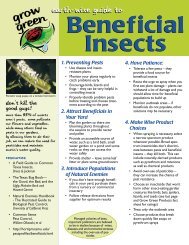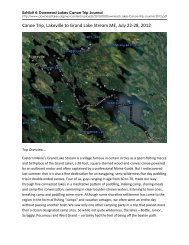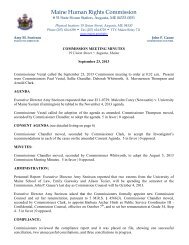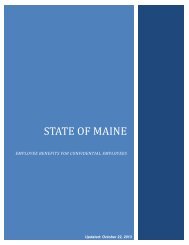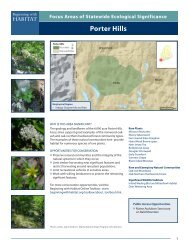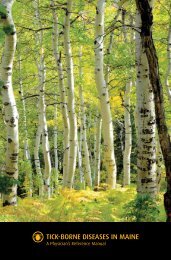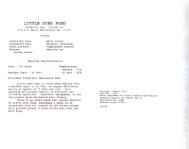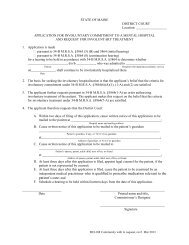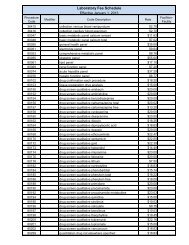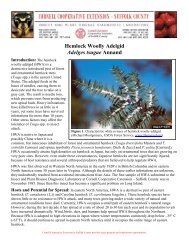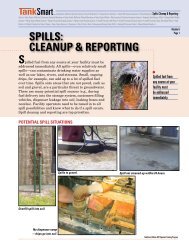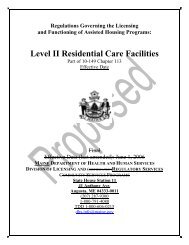BIOPHYSICAL REGIONS - Maine.gov
BIOPHYSICAL REGIONS - Maine.gov
BIOPHYSICAL REGIONS - Maine.gov
You also want an ePaper? Increase the reach of your titles
YUMPU automatically turns print PDFs into web optimized ePapers that Google loves.
Appendix 7 Biophysical Regions of <strong>Maine</strong><br />
Biophysical Regions of <strong>Maine</strong><br />
The following description of <strong>Maine</strong>’s 15 biophysical regions is excerpted from The<br />
biophysical regions of <strong>Maine</strong>: Patterns in the landscape and vegetation (McMahon<br />
1990).<br />
Boundary Plateau Region<br />
Physiography: The Boundary Plateau Region extends from the St. Francis River south to<br />
Penobscot Lake along the <strong>Maine</strong>-Quebec border and includes the lands west of the Saint John<br />
River and Boundary Mountains. The region is a relatively flat featureless plateau with few ponds<br />
and lakes. Elevations average between 1000’ and 1200’ except for a cluster of gently rolling hills<br />
in the southern section that rise to elevations of 1600’ or more. The northwestern portion of the<br />
region is underlain by mélange – a sheared, fine-grained pelitic matrix mixed with angular and<br />
poorly sorted inclusions of diverse origins and geologic ages. Bedrock of the southern portion is<br />
dominated by weakly metamorphosed interbedded pelite (mudstone) and sandstone. The<br />
geology of this part of the state has not been mapped in detail.<br />
Climate: Based on climate observations from the first half of the century (there are no weather<br />
stations in the region), the Boundary Plateau experiences the harshest winters in <strong>Maine</strong>. The<br />
frost-free season is approximately 80 days, which is less than half that of south coastal <strong>Maine</strong>.<br />
The April to November heat sum for the northern portion of the region (2100 degree days) is the<br />
lowest in the state. Average annual snowfall ranges from 100” to 110” and average minimum<br />
January temperature is less than 0° F. Average maximum temperature in July is 77° F, which is<br />
comparable to other regions in northern <strong>Maine</strong>. Average minimum July temperature (52° F) is<br />
the lowest in the state.<br />
Surficial Geology and Soils: The Boundary Plateau Region is dominated by the most extensive<br />
stagnation moraine in the state. This moraine, which is composed of thin, course- textured<br />
ablation till, overlies dense basal till and is dissected by scattered outwash deposits, lake bottom<br />
deposits, and stream alluvium. Extensive areas of thin drift surround the moraine. This parent<br />
material, which is derived from fine-grained shales, slates, and phyllites, has given rise to very<br />
deep loamy soils. In the northern portion of the region, shallow (10”-20”) somewhat excessively<br />
drained Thorndike soils occur on ridges of thin drift, with deeper (> 60”) moderately well drained<br />
Chesuncook soils on midslopes, and somewhat poorly drained Telos soils on lower slopes.<br />
Dense basal till typically underlies the course loamy Monarda and Burnham and the finer Daigle<br />
and Aurelie soils that are characteristic of valleys and broad flat uplands of the region. The<br />
basal till keeps the water table at or near the surface for 7 to 9 months of the year.<br />
Vegetation and Flora: The poorly drained uplands and valleys of the region support large<br />
stands of Picea rubens, Picea mariana, and Abies balsamea. Drier ridges support northern<br />
hardwood species such as Acer saccharum and Betula alleghaniensis. Species richness of<br />
woody plants is low relative to the rest of <strong>Maine</strong>, averaging only 94 species. By comparison,<br />
midcoast <strong>Maine</strong> supports more than 190 species. The Boundary Plateau region also supports<br />
the highest concentration of ribbed fens in the state. A cluster of 14 ribbed fens is located in the<br />
slightly sloping lowland between the Daaquam River and the Southwest Branch of the St. John<br />
River – an area of impeded drainage.<br />
1



